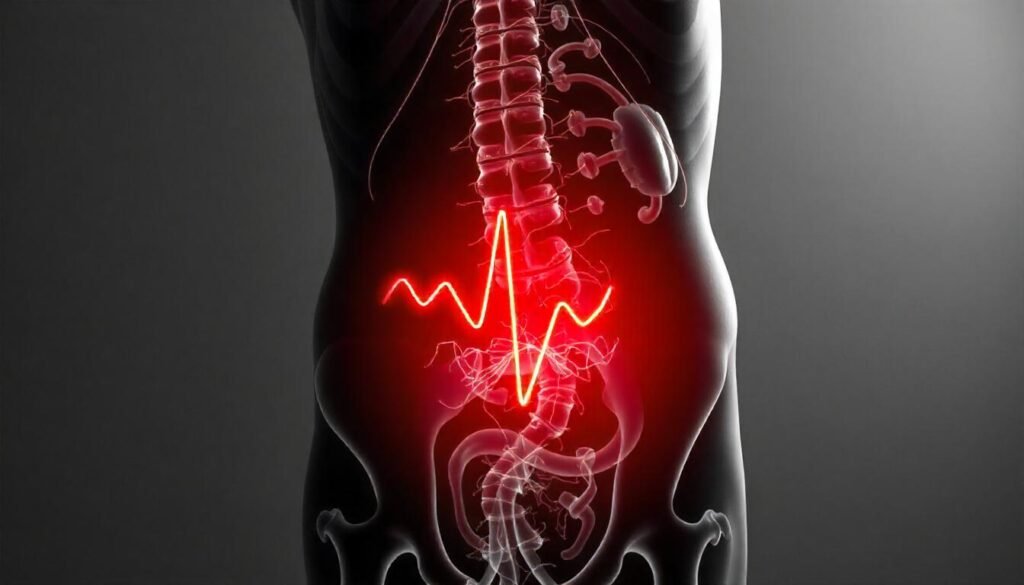Introduction
This article provides a comprehensive guide to the 03 symptoms of aortic aneurysm. An aortic aneurysm is a potentially life-threatening condition that occurs when a section of the aorta, the largest artery in the body, becomes weakened and bulges. This bulging can lead to serious complications, including rupture, which can be fatal. Recognizing the symptoms of an aortic aneurysm is crucial for early detection and treatment. In this article, we will explore the symptoms of aortic aneurysm, the risk factors associated with the condition, and actionable insights to help you stay informed and proactive about your cardiovascular health.

Table of Contents
What is an Aortic Aneurysm?
Before diving into the symptoms of aortic aneurysm, it’s essential to understand what an aortic aneurysm is. The aorta carries blood from the heart to the rest of the body, and it is divided into several sections: the ascending aorta, aortic arch, descending aorta, and abdominal aorta. Aneurysms can occur in any of these sections, but they are most commonly found in the abdominal area (abdominal aortic aneurysm) and the chest (thoracic aortic aneurysm).
Types of Aortic Aneurysms
- Abdominal Aortic Aneurysm (AAA): This specific type of aneurysm occurs in the section of the aorta that extends through the abdominal region of the body. Often, individuals may not exhibit any noticeable symptoms of aortic aneurysm associated with this condition until it reaches a critical point and ruptures, which can lead to severe and life-threatening complications. The lack of symptoms in its early stages makes it particularly challenging to detect and treat in a timely manner, underscoring the importance of regular medical check-ups for those at risk.
- Thoracic Aortic Aneurysm (TAA): This particular kind of aneurysm develops in the chest area, specifically affecting the part of the aorta contained within the thoracic cavity. Similar to its abdominal counterpart, the thoracic aortic aneurysm can remain asymptomatic during its initial stages, which means it does not present any clear symptoms of aortic aneurysm that might alert an individual to its presence. The silent progression of this condition can pose significant risks, as sudden rupture may occur without warning, emphasizing the necessity for monitoring and proactive management in individuals with predisposed factors.

Understanding these types can help you identify the specific symptoms of aortic aneurysm related to each.
Symptoms of Aortic Aneurysm
Early Symptoms of Aortic Aneurysm
Aortic aneurysms often develop slowly and may not present noticeable symptoms of aortic aneurysm initially. However, as the aneurysm grows, some individuals may experience:
- Back Pain: Experiencing persistent or severe discomfort in the back or abdomen region can serve as an early warning sign of an aortic aneurysm. Such pain may not be commonplace and can often be overlooked or mistaken for more benign issues. If the pain is continuous or particularly intense, it is crucial to pay attention, as this could indicate a serious underlying problem that warrants medical evaluation.
- Chest Pain: Some individuals affected by this condition may describe a profound, aching sensation located in the chest area. This type of pain can sometimes be easily confused with symptoms of aortic aneurysm associated with other medical issues, such as heartburn, which is commonly experienced after eating, or muscle strain that can occur following physical exertion. The challenge lies in distinguishing this specific type of chest pain from these more common ailments, making it important to seek professional medical advice if the pain persists.
- Shortness of Breath: An individual may encounter episodes of difficulty in breathing or an overwhelming feeling of breathlessness. These symptoms of aortic aneurysm can arise, particularly in cases where the aneurysm is located in the thoracic region of the body. When the thoracic area is impacted, the body may react by restricting airflow, leading to discomfort and anxiety. It is essential for those experiencing such symptoms to consult a healthcare provider to determine the underlying causes and receive appropriate care. a feeling of breathlessness can occur, especially if the aneurysm affects the thoracic area.

Advanced Symptoms of Aortic Aneurysm
As the aneurysm enlarges, symptoms of aortic aneurysm may become more pronounced:
- Pulsating Sensation: One of the most noticeable signs that may emerge in the case of an abdominal aortic aneurysm (AAA) is a distinct pulsation felt near the area of the navel. This pulsating feeling can be concerning and is often an indicator of the presence of an aneurysm. It is important to monitor this sensation closely, as its presence warrants further medical evaluation to determine the seriousness of the condition.
- Sudden, Severe Pain: A critical warning sign to be aware of is the occurrence of sudden and intense pain that may arise in various locations such as the abdomen, back, or chest. This type of severe pain can serve as a significant signal that a rupture may have taken place, indicating a dire medical emergency. Such a situation necessitates immediate attention from healthcare professionals, as timely intervention is crucial to managing the potential complications that come with a rupture.
- Dizziness or Fainting: In instances where the aneurysm experiences a rupture, it can lead to substantial internal bleeding within the body. This alarming situation often results in symptoms of aortic aneurysm such as dizziness or even a loss of consciousness. Both of these symptoms of aortic aneurysm highlight the urgent nature of the medical condition, suggesting that immediate medical care is essential to address the internal bleeding and stabilize the patient’s condition.

Symptoms of Rupture
A ruptured aortic aneurysm is a medical emergency. The symptoms of aortic aneurysm include:
- Sudden and Severe Pain: Individuals may experience a sudden and sharp pain that feels intense and can radiate outward to areas such as the back or legs, creating a sensation that is difficult to ignore. This type of pain can manifest unexpectedly and may be alarming, often indicating an internal issue that requires immediate medical attention.
- Rapid Heart Rate: Alongside the pain, a person may notice a racing heartbeat, which occurs as the body responds to the potential for blood loss. This increased heart rate is the body’s attempt to maintain adequate blood flow and oxygen to vital organs during a distressing event. It can be accompanied by feelings of anxiety or unease as the body goes into a heightened state of alertness.
- Shock Symptoms: In addition to the aforementioned symptoms of aortic aneurysm, an individual may begin to display signs of shock, which can include clammy or cold skin, a sense of confusion or disorientation, as well as extreme weakness and fatigue. These symptoms are serious indicators of significant blood loss impacting the body’s ability to function properly, and they require prompt medical evaluation and intervention to address the underlying cause and stabilize the individual.
Risk Factors for Aortic Aneurysm
Understanding the risk factors for an aortic aneurysm can help you take preventive measures. Some common risk factors include:
- Age: Aortic aneurysms are more common in individuals over 65 years old.
- Gender: Men are at a higher risk than women.
- Family History: A family history of aortic aneurysms increases your risk.
- Hypertension: High blood pressure can weaken the aorta over time.
- Smoking: Tobacco use is a significant risk factor for the development of aortic aneurysms.
- Atherosclerosis: Hardening of the arteries can contribute to the formation of aneurysms.
Diagnosis and Treatment
Diagnosis
If you suspect you have an aortic aneurysm, it is crucial to seek medical attention. Diagnosis typically involves:
- Imaging Tests: Ultrasound, CT scans, or MRI can help visualize the aneurysm’s size and location.
- Physical Examination: A healthcare provider may check for a pulsating mass in the abdomen or abnormal sounds in the heart.

Treatment Options
Treatment for an aortic aneurysm depends on its size and growth rate:
- Monitoring: For small aneurysms that do not present any symptoms of aortic aneurysm, a watchful approach is often taken, which involves regular imaging tests to track their size and any changes over time. This careful monitoring allows healthcare providers to determine if any alterations occur that might necessitate different management strategies in the future.
- Medications: The use of medications designed to control blood pressure plays a significant role in managing conditions such as hypertension. By effectively lowering blood pressure, these medications can significantly decrease the likelihood of an aneurysm rupturing, thus providing a crucial protective effect for patients with existing aneurysms.
- Surgery: When it comes to larger aneurysms or those that exhibit symptoms of aortic aneurysm, surgical intervention is frequently required to address the condition adequately. This surgical approach may take the form of traditional open surgery, where the area is surgically accessed directly, or it may involve a less invasive technique known as endovascular repair, which often requires fewer recovery resources and time for the patient.
Preventive Measures
While not all aortic aneurysms can be prevented, certain lifestyle changes can significantly reduce your risk:
- Quit Smoking: If you currently smoke, it is highly advisable to seek professional help and support to successfully quit. Stopping smoking is widely regarded as one of the most effective strategies to significantly reduce your risk of various health issues, particularly those related to the heart and lungs.
- Manage Blood Pressure: It is important to regularly monitor your blood pressure levels and to closely follow the recommendations and guidance provided by your healthcare provider. Keeping your blood pressure within a healthy range is crucial for maintaining your overall health and reducing the risk of serious complications.
- Healthy Diet: Consider adopting a heart-healthy eating plan that is rich in a variety of fruits and vegetables, whole grains, and sources of lean proteins. Such a nutritious diet can play a vital role in supporting your cardiovascular health while providing essential nutrients for your body.
- Regular Exercise: Make it a priority to engage in regular physical activity that fits your lifestyle, as this can help you maintain a healthy weight and promote cardiovascular health. Incorporating exercise into your routine has numerous benefits, including improving heart function and enhancing overall well-being.
Conclusion
Understanding the symptoms of aortic aneurysm is crucial for early detection and treatment. If you experience any of the symptoms of aortic aneurysm mentioned, especially sudden, severe pain, seek medical attention immediately. By being aware of the risk factors and taking preventive measures, you can significantly reduce your chances of developing this serious condition.
Call to Action
Stay informed about your cardiovascular health. Schedule regular check-ups with your healthcare provider and discuss any concerns you may have regarding aortic aneurysms or other heart-related issues.
Frequently Asked Questions (FAQ)
1. What are the common symptoms of an aortic aneurysm?
Some of the frequently observed symptoms of aortic aneurysm encompass back pain, discomfort in the chest area, difficulty in breathing, and a noticeable pulsating feeling in the abdominal region. It is important to note that if someone experiences sudden and intense pain, it could be a sign of a potential rupture, which may require immediate medical attention to address the situation appropriately.
2. How is an aortic aneurysm diagnosed?
The process of making a diagnosis usually includes several key components, prominently featuring imaging tests, which may consist of ultrasound, CT scans, or MRI. In addition to these imaging techniques, a thorough physical examination conducted by a qualified healthcare provider is also an essential part of the diagnostic procedure. This combination of advanced imaging and careful hands-on assessment helps ensure that a comprehensive evaluation of the patient’s condition takes place.
3. What are the risk factors for developing an aortic aneurysm?
The various risk factors that contribute to this condition encompass several important aspects, including the person’s age, with older individuals typically being at a greater risk. Additionally, gender plays a significant role, as studies indicate that men tend to have a higher risk compared to women. Furthermore, a family history of the condition can increase susceptibility, indicating that genetics may have an influential factor.
Other notable risk factors include hypertension, which refers to elevated blood pressure levels, alongside lifestyle choices such as smoking, which is a well-known contributor to various health issues. Lastly, the presence of atherosclerosis, a condition characterized by the build-up of plaques in the arteries, is also considered a critical risk factor that can lead to serious health complications.
4. Can an aortic aneurysm be prevented?
Although it is true that not every type of aneurysm can be entirely prevented, there are several effective lifestyle modifications that individuals can adopt to significantly lower their risk. By quitting smoking, for instance, one can greatly improve overall vascular health, as smoking is known to contribute to the formation of aneurysms.
Additionally, managing blood pressure through regular check-ups and appropriate interventions can help prevent the stress on blood vessels that leads to this condition. Furthermore, maintaining a nutritious and balanced diet rich in fruits, vegetables, and whole grains supports overall heart health and contributes to risk reduction.
5. What should I do if I suspect I have an aortic aneurysm?
If you encounter symptoms of aortic aneurysm that include sudden and severe pain, it is crucial that you seek medical attention without delay. Prompt evaluation by a healthcare professional can make a significant difference in your treatment options. Remember, early detection is vital, as it plays a key role in ensuring effective treatment and better health outcomes. Don’t hesitate to get help as soon as possible if you find yourself experiencing such symptoms.
By understanding the symptoms of aortic aneurysm and risk factors associated with aortic aneurysms, you can take proactive steps to safeguard your health and well-being.
 >
>